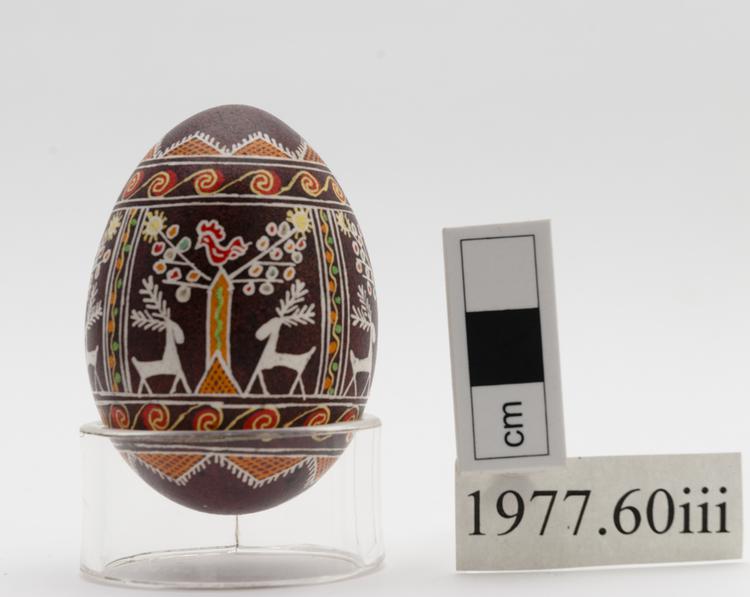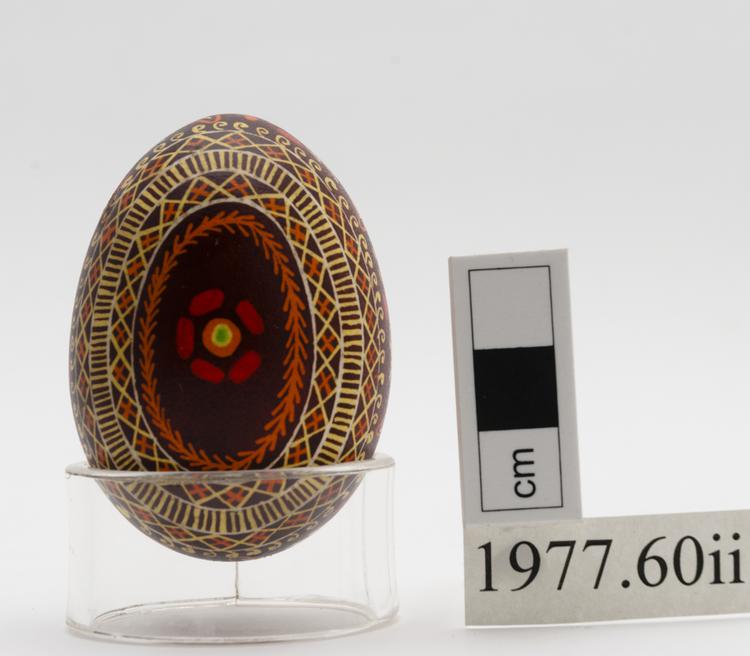The Origins of Pysanka
This long history of egg painting in Ukrainian and Slavic culture are believed to date back millennia but the oldest example was found dates back to 15/16th century. Due to the fragility of eggs, evidence is hard to find intact although ceramic eggs have been found in Ukraine dating back to the 5th millennium BCE. The origins of the practice are not totally clear.
Some link the tradition to the beginning of spring, representing the return of sunshine after a long winter. The yellow yolk is thought to symbolise the sun.
Another pre-Christian legend tells the story of a monster in the Carpathian mountains. In this story, the more pysanky (plural) people make, the longer the monster figure is kept shackled.
Christianity likely strengthened and morphed this tradition, since eggs are a common symbol around Easter. Traditional designs on the eggs are also imbued with meaning.
The tradition of Pysanka has grown since Ukrainian independence in 1991, along with other folk art.

Practice of Pysanka
The practice of egg painting most commonly begins with krashanka, a boiled egg dyed a single colour. Before chemical dyes became common, people would use natural botanical dyestuffs to make the dyes, usually made from onion skins.
Decorating eggs utilises the process of wax-resist dyeing, applying hot wax to the shell, which is then placed in a series of dye baths. The wax prevents the dye from reaching the surface of the egg, meaning multiple layers of wax and colour can be applied by artisans. Nowadays, some will decorate using other materials on the form of an egg, such as wood or ceramic elements.
Design, meaning and colour
The most common decorations feature complex geometric and aesthetic designs.
The triangle is said to symbolize the Holy Trinity. In ancient times, it perhaps symbolised other trinities too, such as the elements of air, fire and water, or the cycle of life, birth, and death. Christian imagery is also sometimes depicted in egg decoration, such as the Church. Again, Church parts are usually in threes: three stories/roofs, three church towers or three windows.
Plant and animal motifs are also a regular theme in pysanky decorating. Ukrainians who created pysanky were often inspired by the natural world, with designs depicting flowers, trees, fruits and leaves and in ambiguous ways. Pysanky created by the people of the Hutsul region of Ukraine for example, often showed a fir tree branch, a symbol of youth and eternal life.
This one from our collection is a good example of this, with a tree, bird and deer. The deer signify wealth and prosperity, while the bird represents spring and fertility.

The spirals in this one signify defence and protection, while the crosses represent Christ and the four corners of the world.

easter egg
Anthropology
When using onion skins, the natural dye would be red, which is the most common symbolic colour of pysanka with a variety of meanings such as blood, love and the sun. Yellow is said to represent the harvest, blue the skies, and green the coming of spring. Some colour combinations also have traditional meaning too, black and white to denote mourning, and multiple colours representing joy and prosperity.
Patriotic and political designs have also been depicted on eggs. This includes Ukrainian flags and tridents which have come become popular symbols of resistance and national pride through independence and invasion.
Intangible Cultural Heritage
In 2003, UNESCO adopted a treaty seeking to further safeguard and cultural heritage, which came into effect in 2006.
Crucially, this was an effort to recognise cultural heritage considered intangible, acknowledging the small details of our way of life not limited to monuments, buildings and objects. The term intangible comprises traditions inherited from our history, such as oral traditions, performing arts, social practices, rituals, events, crafts and knowledge.
Whilst the Pysankas in our collection are a tangible example of cultural heritage, it is the practice of egg decoration itself that UNESCO has recently named as Intangible Cultural Heritage of Humanity.


